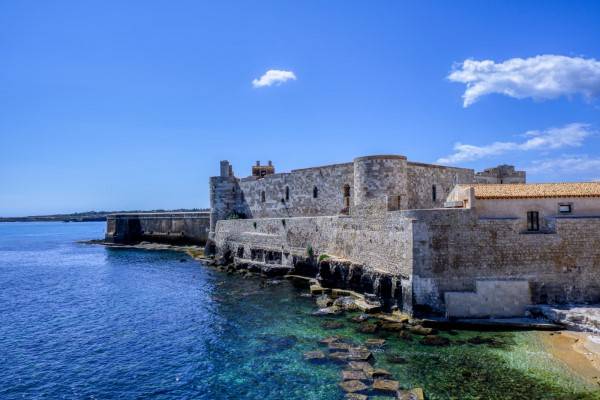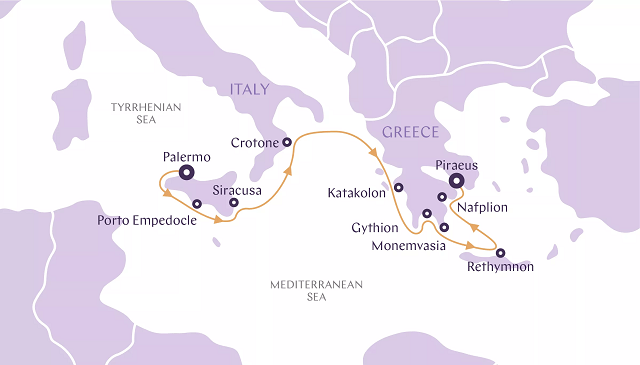HIGHLIGHTS
- Munch your way around the Palermo’s bustling street markets
- Learn more about Archimedes while searching for his tomb in the necropolis at Siracusa
- Sit among the ruins at Olympia, home of the first Olympic Games in 775 B.C.
- Uncover Rethymno’s multicultural past and explore its picturesque lanes
- Wander medieval alleyways in the 6th-century castle town of Monemvasia
DATES / RATES
Rates are listed per person
|
| Start Date | End Date | From EUR | From USD |
|---|
Rates are listed per person
|
| Start Date | End Date | From EUR | From USD |
|---|
ITINERARY
PALERMO
DAY 1
A feast for the senses, Sicily’s capital is an intoxicating and chaotic melting pot. Bustling street markets, ancient buildings, opulent palaces and millennia of history await those ready to embrace Palmero for all that it offers. Palmero’s history is complex, to say the least. Middle Eastern, Northern African and European influences are all melded together here. The Greeks, Romans, Carthaginians, Arabs, Goths and Vandals have come and gone through the ages, leaving countless treasures in their wake. The 12th-century Arab-Norman cathedral, built over a 9th-century mosque, houses the tombs of the Norman rulers and is a fitting manifestation of the city’s convoluted past. The opulent Palazzo de Normanni, once the seat of power for the kings of Sicily during Norman rule, is a dazzling display of the opulence that the city’s rulers once enjoyed.
PORTO EMPEDOCLE
DAY 2
Situated on the south-western coast of Sicily, Porto Empedocles was named after the philosopher Empedocles who lived in the region in the 5th century BC. The marina town serves as a gateway to the highlights of Sicily’s Agrigento region, including the archaeological Valley of the Temples. This UNESCO World Heritage site dates back to the 5th century BC and houses some of the best-preserved Ancient Greek ruins in the world outside of Greece. The nearby town of Agrigento has a medieval core and several interesting archaeological sites. Wander through its narrow, winding alleyways and explore the smart shops, lively restaurants and friendly bars.
SIRACUSA
DAY 3
Once the biggest city in the ancient world, Siracusa wears its history proudly on just about every street corner. Ancient Greek ruins rise out of heavenly citrus orchards, traditional cafes tumble onto baroque piazzas and ancient lanes lead down to the sparkling Mediterranean, as they have for millennia. The city was founded in 734 BC by Corinthian colonists, and the ruins of the original city can be explored at the Parco Archeologico della Neapolis, one of Sicily’s greatest archaeological sites. Nearby you can also visit the macabre yet fascinating necropolis, housing some of the region’s most renowned historical figures, including the famed mathematician Archimedes.
CROTONE
DAY 4
Cruise along the Calabrian coast and enjoy the scenery of rugged cliffs and sandy beaches. As we pull into the port town of Crotone, notice the 16th-century fortress, Castle of Charles V. Inside its museum is a golden tiara, found nearby in the Capo Colonna Archaeological Park named for its column that stands proud on a promontory. Crotone itself is a delightful mix of old and new, from the ancient city walls to the cathedral notable for its icon of the Black Madonna alongside Calabrese restaurants serving traditional pasta and sausage dishes.
KATAKOLON
DAY 5
Olympia, the birthplace of the Olympic Games is a short drive away from this pretty Greek harbour town. Take time to explore the ancient stadium that sat 45,000 at the first Olympics in 776 BC, and then every four years, to honour the god Zeus. Look out for the marble starting blocks and the ruins of the Temple of Zeus, where once stood a 12m-tall gold statue of Zeus, one of the Seven Wonders of the ancient world. North of Katakolon, explore wineries or stop for lunch at the harbour and sample some of their produce.
GYTHION & MONEMVASIA
DAY 6
The island’s main draw today is its incredible natural environment. Sitting on the southern side of the Peloponnese, Gythion is blessed with tranquil beaches and turquoise waters where turtles breed. The island of Cranae is just a causeway’s walk away from Gythion and is allegedly where Paris of Troy and Helen from Sparta spent their first night together. Further out of town, you can visit the 13th-century Byzantine citadel of Mystras, a UNESCO World Heritage Site. On a small islet attached to the mainland, the preserved 6th-century medieval castle town of Monemvasia sits under a cliff at the edge of the sea. Ramble around the cobblestone alleys of this storied castle, before stopping for a rooftop lunch at one of the houses.
RETHYMNON
DAY 7
First inhabited by the Minoans, the Venetians and then the Turks, this romantic port has seen many styles of occupation through the ages. The city’s multicultural history is immediately evident as you begin exploring its enchanting lanes. Venetian fortifications intersperse orthodox and catholic churches and mosques. Ancient mansions with floral canopies and ornate monuments adorn the charming Venetian-Ottoman quarter. The harbour area offers an atmospheric setting for an evening meal, and just above the imposing Fortezza castle stands guard over the town. If you are feeling energic, take a walk to the castle up Palekastro Hill for spectacular views of the sparkling Mediterranean below.
NAFPLIA
DAY 8
Considered one of the romantic cities in Greece, Nafplio, believed to have been founded by Poseidon’s son, Nafplios, was the first modern Greek capital from 1823–34. From ancient fortresses, such as the Acronafplia dating back to the Bronze Age and Romans, to an attractive coastline with pebble beaches and a waterfront promenade lined with cafes and shops, it’s a picture-perfect spot for a bit of downtime. After our quick stop in Nafplio, we sail through the Corinth Canal. Only small ships can safely navigate this steep-sided narrow canal - only 21 m wide. Sit up on deck as we squeeze through this precarious waterway and admire the feat of Victorian engineering.
PIRAEUS
DAY 9
Greece’s buzzing cosmopolitan capital is served by Piraeus port and is an exciting mix of ancient and modern. Walk the Grand Promenade that winds beneath the city’s most famous landmark, the Acropolis. This walkway, built during the 2004 Olympic Games, links the city’s main archaeological sites. No visit to Athens is complete without seeing the Acropolis itself of course. Start with the Acropolis Museum for some informative context and then walk the marble path up Filopappou Hill for majestic views of the ‘high city’ with the iconic Parthenon perched on top (a temple dedicated to the goddess Athena, patron of the city).
 (Click image to view Ship details)
(Click image to view Ship details)
WHAT'S INCLUDED
- Group return transfers from the airport to the cruise port (via our included accommodation where applicable)
- One night pre-cruise accommodation with breakfast in a 4/5-star hotel or onboard
- All meals onboard
- Onboard accommodation in a stateroom selected category
- 24-hour room service
- Coffee, tea, soft drinks and selected alcoholic beverages available 24-hours per day
- Lecture programmes by our experienced expedition team and guest speakers
- One selected shore excursion/expedition activities per port of call
- Branded Swan Hellenic expedition parka and use of rubber boots in Polar Regions
- Standard WiFi
- Onboard gratuities & port taxes







